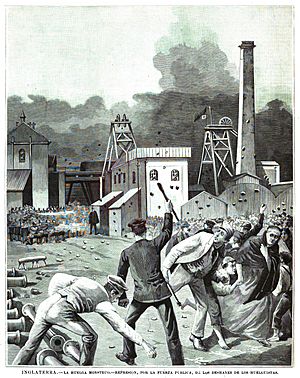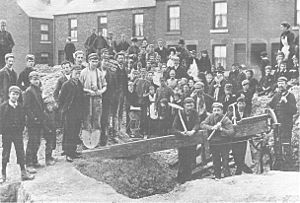UK miners' strike (1893) facts for kids
The 1893 miners' strike was a very big event in Great Britain. It involved about 300,000 coal miners. This made it the largest strike the United Kingdom had ever seen at that time.
Contents
The Great Coal Miners' Strike of 1893
This huge strike happened across many parts of Great Britain. It involved miners from areas like Yorkshire, Lancashire, Cheshire, and Nottinghamshire. All these areas had strong worker groups called unions. These unions were part of a bigger group called the Miners' Federation of Great Britain (MFGB).
Why Did the Miners Go on Strike?
The price of coal had been falling since the early 1890s. To try and help, the MFGB told its members to take a week's holiday in March 1892. This was to reduce the amount of coal available. Most miners followed this, even though mine owners were not happy. Owners worried about losing money and the MFGB getting stronger.
Around the same time, mine owners in County Durham wanted to cut miners' wages by 10%. The miners' union there, the Durham Miners' Association (DMA), voted strongly against this. Because of this, the owners stopped the miners from working. This is called a lockout. The Durham miners eventually lost. They went back to work after 12 weeks with their pay cut. This experience made the DMA join the MFGB.
The Main Strike Begins
Miners in the Federated District kept their pay levels until June 30, 1893. Then, the mine owners announced a big 25% cut in wages. The MFGB strongly opposed this. By the end of July, most union miners in the district were locked out of their pits. Only a few people, called strikebreakers, continued to work.
Some miners started striking themselves because they hadn't been told about a pay cut. However, miners in Durham, Northumberland, and Monmouthshire did not join this big action. Their unions either left or were removed from the MFGB.
Clashes and a Tragic Event
During August, there was a tense waiting period. But in early September, there were many fights between striking miners and strikebreakers in Yorkshire. The government sent soldiers to the areas where violence was happening. The Yorkshire Miners' Association asked everyone to stay peaceful.
On September 7, a sad event happened in Featherstone. Two miners were killed by soldiers. This became known as the "Featherstone Massacre."
How the Strike Ended
The MFGB agreed that miners could slowly go back to work if they could get their old pay. By the end of October, fewer miners were locked out. The mine owners then changed their demand to a 15% wage cut.
A meeting was held in Derby in November. It was led by A. J. Mundella. The MFGB still refused any pay cuts. They also wanted a special group, called a board of conciliation, to help solve future problems.
Another meeting was organized, this time led by Lord Rosebery. At this meeting, they agreed to create the Board of Conciliation. They also agreed that miners would go back to work with no pay cuts. And no cuts would happen before February 1, 1894.
Having won their main demands, the miners returned to work on November 17. By February 1894, coal prices had gone up. This meant that in July, both sides could agree to a 10% pay cut, with no more cuts after that.



